It’s time to deliberate on what makes for humble leadership. As already mentioned, the discussions and interviews I had with various leaders led to a framework of beliefs and thoughts, in other words, the attitudes or mindset of humble leaders. These are referred to in this book as ‘Attitudinal Characteristics’. They are:
- Appreciative mindset
- Positive about possibilities
- Path-showing
- Lightheartedness
- Evolutionary frame of mind

For ease of remembering these five attitudinal characteristics, one can use the acronym using the first letter of each characteristic— APPLE. Under each one of these attitudinal characteristics, three attributes have been identified to explain the characteristic in detail. Figure 1 makes it clearer for the reader.
Chapters 1 to 5 are devoted to one characteristic each and their associated attributes. These chapters try and give a fair idea as to what humble leaders believe and how they think; that is, their attitude and mindset. Further, based on the information gathered from the leaders interviewed, what I heard from the people who worked closely with these leaders, and my own observations and experiences, I have identified five characteristics that humble leaders possess. These are behavioural in nature, in the sense that these are the traits of humble leaders in the context of how they behave with people who work with them. For ease of understanding these characteristics, the acronym IMAGE is formed, using the first letter of each word or phrase that describes the behavioural characteristic. The following are the five behavioural characteristics:
- Intensity
- Mindful excellence
- Ahead of one’s time
- Gratitude
- Establishing emotional connect

Again, three attributes under each of these characteristics have been identified, as shown in Figure 2. Readers will find each one of these behavioural characteristics dealt with separately under Chapters 6 to 10. When leaders possess the attitudinal characteristics shown in the APPLE framework (Figure 1), their teams can expect the resultant behavioural characteristics shown in the IMAGE framework (Figure 2). These attitudinal and behavioural characteristics among its leaders can go a long way in bringing about three cultural outcomes for an organization—the culture of high people engagement, the culture of high experimentation and the culture of high performance—as shown in the integrated framework (Figure 3):

Once these models—APPLE and IMAGE—and the integrated framework are assimilated, developing leaders as humble high achievers is but a step away. This is what the second section of this book is about, as it explains our experiences in building humble leaders and gives a few leadership development constructs for organizations to use. However, this will be a brief section, since the development of humble high achievers calls for imparting experiential learning and not just theoretical principles, concepts and formulas.
Also read: ‘Best and most boring’—Brezhnev’s rule wasn’t USSR’s worst era
Appreciative Mindset
‘Disneyland will never be completed. It will continue to grow as long as there is imagination left in the world.’ —Walt Disney
What is your biggest frustration at this point in time? Is it your job that doesn’t pay you enough? Your spouse who nags and tries to control you? Or, is it your manager who never seems to understand your aspirations and doesn’t recommend your case to the ‘higher-ups’ for a promotion? If such feelings of discontent are too strong, it’s possible that you wake up every morning thinking about your job, your spouse or your manager. Vexing thoughts come to your mind as soon as you get up; thoughts like ‘Why is this happening to me?’, ‘How unreasonable is he/she’ or ‘Why can’t I earn as much as some of my other friends do?’ A time comes when these thoughts spiral out of control as you brood over them. Or perhaps your frustration just pops into your consciousness occasionally and lingers there only for a while, but long enough to spoil your mood. If any of these scenarios is correct, I suggest you put this book down, get a piece of paper and make a note of the source of your frustration—your salary, spouse, manager, or that elusive promotion.
Mention the area of frustration at the top of the sheet. Then, with a little bit of effort, shift your thinking to try and focus on what’s working, what’s strong, what’s the best and what’s possible—in short, you should also look at the positive factual data points pertinent to the area you have just identified as the source of your bitterness. Let’s say it is your spouse who is the source of your frustration. Now, when you write down what’s working in this relationship, you might come up with words and expressions like ‘companionship for the last xyz years’, ‘support during sickness’ and ‘parent to the children’.
Similarly, when you focus on ways to improve your relationship with your spouse, a whole lot of possibilities could come up! This means you have just shifted your mind from deficit thinking to appreciative thinking. When you do this regularly and make it a habit, developed by practice, you will have an appreciative mindset— the starting point of humility in leadership.
Unfortunately, the appreciative mindset does not come naturally to us. What is most natural is the deficit mindset—when we focus on what’s missing and what can’t be done. This is mainly due to our early upbringing—at home, at school and the wider education system—when we were constantly told to identify problems and fix them.
 This excerpt from ‘The Power of Humility’ by PV Ramana Murthy has been published with permission from Harper Collins.
This excerpt from ‘The Power of Humility’ by PV Ramana Murthy has been published with permission from Harper Collins.



